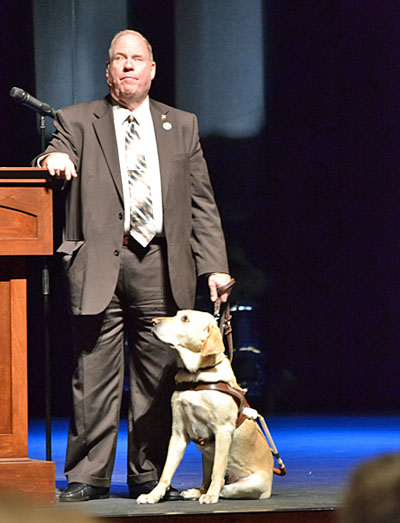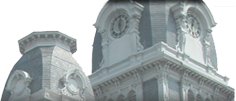Being blind didn’t hamper 9/11 survivor
DAVE MOSIER/independent editor

The Niswonger Performing Arts Center’s commemoration of the 9/11 terrorist attacks went from the dramatic and powerful to the quiet … and powerful … when World Trade Center survivor Michael Hingson took the stage on Tuesday evening.
Hingson, who became blind shortly after birth, led a number of people from the 78 floor of Tower 1 of the World Trade Center to safety, with the help of his guide dog, Roselle. Hingson’s 9/11 story is poignant, yet only a small part of the tale of his lifelong fight against discrimination and unequal treatment of those with disabilities.
That story is told in Hingson’s book, Thunder Dog: The True Story of a Blind Man, His Guide Dog and the Triumph of Trust at Ground Zero, which has been on the best-sellers’ list since its release in August.
Hingson’s parents taught him to not limit himself and fought to have him attend regular public schools, rather than a special school for the blind. He did well in school and went on to graduate with a master’s degree in physics from the University of California at Irvine.
After working with the inventor of the Kurzweil Reading Machine, the world’s first all-font optical character recognition system — a tool used extensively by the blind that scanned and read characters from a document — Hingson later became a successful salesman and was working in that capacity for Quantum, a Fortune 500 company that made high-tech tape backup systems, from an office high up in the World Trade Center on September 11, 2001.
He said neither he nor others in Quantum’s office on the 78th floor of Tower 1 knew what was happening when American Airlines Flight 11 crashed into the side of the building around the 96th floor.
“All of a sudden the building began leaning,” Hingson said, noting that the tower tilted about 20 feet before slowly righting itself.
Both he and a co-worker said their “goodbyes” to each other, thinking the building was going to collapse then, but as Tower 1 recovered from the initial collision, they started thinking about getting out of the building.
That was when Hingson’s blindness became a big asset to their survival. Being a person who had always been able to do the things sighted people could — even riding a bicycle as a young boy — Hingson was confident in his abilities to get out of Tower 1.
Furthermore, because his job responsibilities meant he often took people to lunch or dinner in the World Trade Center, Hingson had walked all over the building and knew the it intimately.
Getting his guide dog (not Seeing Eye dog, Hingson stressed, noting only dogs from the Seeing Eye Institute could be called that), Roselle, Hingson and others began the long and arduous descent down 1,482 steps to get out of the building.
Hingson, far from feeling any disadvantage because of his blindness, said he was more concerned that, if the lights went off in the stairwell, that sighted people would panic because they couldn’t see and hamper others’ escape.
“There were no windows in the stairwell, so it would have been completely dark,” he noted.
Fortunately, that didn’t happen and Hingson’s group eventually got out of the building, although they still didn’t know what was happening and why.
They had met a number of firefighters coming up the stairwell to help those higher in the building – those Hingson called the “true heroes” of 9/11, along with those who died in the attacks, but no one would tell them what was going on.
“Information would have really helped at that point, but we didn’t have any,” he said.
Meanwhile, while he and others were now out of the building, Hingson was only approximately 100 yards away when Tower 1 collapsed. He and Roselle began running to escape the debris and dust that threatened to envelop them and finally got to the entrance to the subway when Roselle stopped abruptly.
Her training had allowed her to stop precisely at the top of the stairs leading into the New York City subway. Traveling even a couple of feet more would have been disastrous for both master and guide dog.
After finding safety from the chaos in the subway, Hingson later reunited with his wife — and finally learned about what had happened and that terrorists had attacked both the World Trade Center and the Pentagon.
He later became something of a media celebrity, appearing on “Larry King Live” and other shows to talk about his experiences.
Those experiences also led to a change for Hingson, who left his nearly 30-year career in sales and sales management and began to work for Guide Dogs for the Blind in California, where he grew up.
Although he no longer has Roselle, Hingson brought his current guide dog, Africa, who lives with the Hingsons, along with Fantasia, Africa’s mother and a retired breeder dog for Guide Dogs for the Blind.
Following his talk, which lasted nearly two hours, Hingson took questions and answers from the NPAC crowd.
POSTED: 09/14/11 at 5:08 am. FILED UNDER: News







